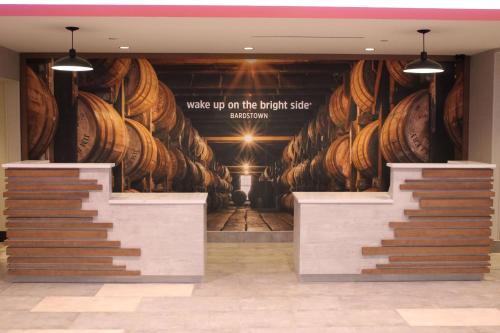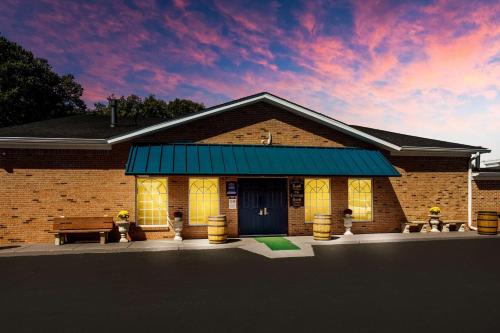Airbnb, Cabins, Vacation Rentals in Kentucky
Compare 29,422 available vacation home properties, starts from $6
Navigate forward to interact with the calendar and select a date. Press the question mark key to get the keyboard shortcuts for changing dates.
Navigate backward to interact with the calendar and select a date. Press the question mark key to get the keyboard shortcuts for changing dates.
Find the best vacation rental
Save Up To 94%
Airbnb, Vacation rentals and hotel deals in Kentucky
9.8 (59 reviews)
Luxurious loft with 3 rooms - Downtown on Court Square
Apart hotel · 2 Guests · 1 Bedroom
$172 /night*

7.9 (105 reviews)
Americas Inn Bardstown
Inn · 2 Guests · 1 Bedroom
$80 /night

9.2 (11 reviews)
La Quinta Inn & Suites by Wyndham Bardstown
Hotel · 2 Guests · 1 Bedroom
$98 /night

10 (59 reviews)
Newly remodeled, Grigsby House in Historic Bardstown
Holiday home · 2 Guests · 1 Bedroom
$263 /night*

9.6 (5 reviews)
Log Cabin by the lake
Cabin · 2 Guests · 1 Bedroom
$225 /night*

8.5 (30 reviews)
Bardstown Motor Lodge
Hotel · 2 Guests · 1 Bedroom
$135 /night

8.6 (109 reviews)
Hampton Inn Lebanon
Hotel · 2 Guests · 1 Bedroom
$117 /night

9.2 (68 reviews)
Lake House near Green River Lake and minutes from several marinas.
Holiday home · 2 Guests · 1 Bedroom
$117 /night*

10 (7 reviews)
*NEW* Bourbon on Broadway- 3 King Bed- Downtown Bardstown
Holiday home · 2 Guests · 1 Bedroom
$294 /night*

10 (97 reviews)
Luxurious Suite w/Garden on Court Square Downtown
Apart hotel · 2 Guests · 1 Bedroom
$172 /night*

10 (1 review)
Private Queen Bedroom w Private Entrance
Apartment · 2 Guests · 1 Bedroom
$65 /night*

9.7 (13 reviews)
Maple Hill Manor Bed & Breakfast
B & B · 2 Guests · 1 Bedroom
$209 /night

10 (23 reviews)
Historic Simmstown Manor Located on Bourbon Trail
Holiday home · 2 Guests · 1 Bedroom
$775 /night*

10 (189 reviews)
Luxurious 2BR /2Bath with Outdoor Courtyard and Garage in Downtown Bardstown
Holiday home · 2 Guests · 1 Bedroom
$267 /night*

9.8 (75 reviews)
Pioneer Park Cottage, 2 BR/2 BA Downtown Historic Bardstown
Cottage · 2 Guests · 1 Bedroom
$202 /night*

5.8 (25 reviews)
Springfield Inn
Hotel · 2 Guests · 1 Bedroom
$94 /night
10 (23 reviews)
5 minutes from downtown Lebanon
Agritourism · 2 Guests · 1 Bedroom
$195 /night*

8.7 (285 reviews)
SureStay Hotel by Best Western Bardstown General Nelson
Hotel · 2 Guests · 1 Bedroom
$90 /night
10 (1 review)
Bourbon Trail Fun Zone! HotTub! Pool Table! Ping Pong! Golden Tee! Big Yard!
Holiday home · 2 Guests · 1 Bedroom
$269 /night*

8.2 (83 reviews)
Holiday Inn Express Campbellsville, an IHG Hotel
Hotel · 2 Guests · 1 Bedroom
$119 /night

What Are The Best Rental Amenities in Kentucky?
Top Rental Amenities in Kentucky
+
Which Price Range Is Most Typical in Kentucky Area?
Vacation Cabin & House Rental Price Information in Kentucky
+
What Are The Popular Property Types in Kentucky?
Rental Property Types in Kentucky
+
How Many Accommodations Are Pets Allowed in Kentucky?
Pets Allowed vs Not Allowed in Kentucky
+
What Are The Must-Visit Places in Kentucky?
Tourist Attractions In Kentucky
+
What are the Airports in Kentucky?
Airports Options in Kentucky
+
How to get around in Kentucky?
Transportations
+
What are the travel peak seasons in Kentucky?
Peak Seasons
+
What are the must-visit places in Kentucky?
Must See Attractions
+
Where to visit in order to explore art and culture in Kentucky?
Art & Culture Places
+
Where are the hidden gems or unique spots to visit in Kentucky?
Hidden Gems
+
What does the calendar look like for local events & festivals in Kentucky?
Local Events & Festivals
+
What are the nightlife spots in Kentucky?
Nightlife Spots
+
What are the activities in Kentucky that are family friendly?
Family Friendly Activities
+
What are the recommended places to eat and drink in Kentucky?
Recommended Local Food & Drinks
+
Unique Destinations in Kentucky
Airbnb, Vacation House with Full Kitchen, and Other Rental Options in Kentucky
Full Kitchen
10 (51 reviews)
Country Farm Home, Travel the Bourbon Trail, & Historic Site
Agritourism · 2 Guests · 1 Bedroom
$275 /night*

Full Kitchen
10 (61 reviews)
Bourbon Cottage, 2 BR, Downtown Historic Bardstown next to Bakery!
Cottage · 2 Guests · 1 Bedroom
$202 /night*

Full Kitchen
9.2 (68 reviews)
Lake House near Green River Lake and minutes from several marinas.
Holiday home · 2 Guests · 1 Bedroom
$117 /night*

Popular Vacation Cities in Kentucky
Other Vacation Rentals Ideas
* The displayed nightly rate may be estimated based on a future travel date. Narrow down your search with checkin and checkout dates to see the exact price.



























































































